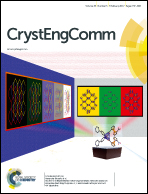Non-classical growth of water-redispersible spheroidal gold nanoparticles assisted by leonardite humate†
Abstract
The growth of gold nanoparticles (AuNPs) assisted by humate – a natural hyperbranched polyelectrolyte – was studied using in situ and ex situ techniques. The conditions for formation of almost monodisperse gold nanospheres of 13 ± 3 nm diameter with pronounced plasmonic properties were defined. A striking similarity was found between humate- and citrate-mediated growth of AuNPs: the formation of gold nanospheres involved rapid nucleation of gold seeds, slow growth within the intermediate agglomerates (visible as nanoworms after drying on a TEM grid), and rapid peptization into the final gold nanospheres. Both humate and citrate syntheses produced ultrastable gold sols with pronounced plasmonic properties. The substantial difference was slower kinetics of humate synthesis, 240 min versus 15 min for citrate, and the water redispersible properties of the humate-capped gold nanospheres after freeze drying, which was not seen with the citrate AuNPs. Theoretical calculations revealed a leading role of steric factors in the formation of intermediate aggregates of capped AuNPs at the stage of their slow growth in the case of both citrate and humate. We suggested that it was the polyelectrolyte nature of humate which enabled the water-redispersibility of humate- versus citrate-capped gold nanoparticles.



 Please wait while we load your content...
Please wait while we load your content...